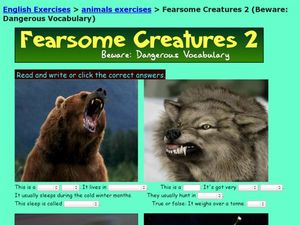National Park Service
Hibernation-Migration-Fascination
What's the difference between hibernation and a good nap? Find out with an engaging life science activity that compares the hibernation habits of grizzly bears and marmots. After learners read an informational passage about each mammal,...
National Park Service
News Bearly Fit to Print
There are an average of three human fatalities by bears in North America every year, which is low when you compare it to the 26 killed by dogs and the 90 killed by lightning annually. The lesson encourages researching human-bear...
Curated OER
Fearsome Creatures 2
In this fearsome creatures worksheet, learners choose the correct words to fill in the blanks to sentences about dangerous animals. Students complete this for 10 animals.
Curated OER
Make Way for Wild Migrants
Students discuss the threats facing migratory species and track the seasonal journeys of wildlife in real space and in cyberspace. Once they have gathered information from several sources, they create a portfolio to share with others...
PBS
Pbs: Nova: Bear Essentials of Hibernation
The hibernation of bears is described in detail. Information about the actions of bears leading up to hibernation, the physiological changes that bears experience during hibernation and the 'waking up' process are given. General black...
Smithsonian Institution
National Museum of Natural History: American Mammals: American Black Bear
Most Black Bears hibernate for up to seven months, and do not eat, drink, urinate, or exercise the entire time. In the South, where plant food is available all year, not all bears hibernate, but pregnant females do. Learn more about the...





